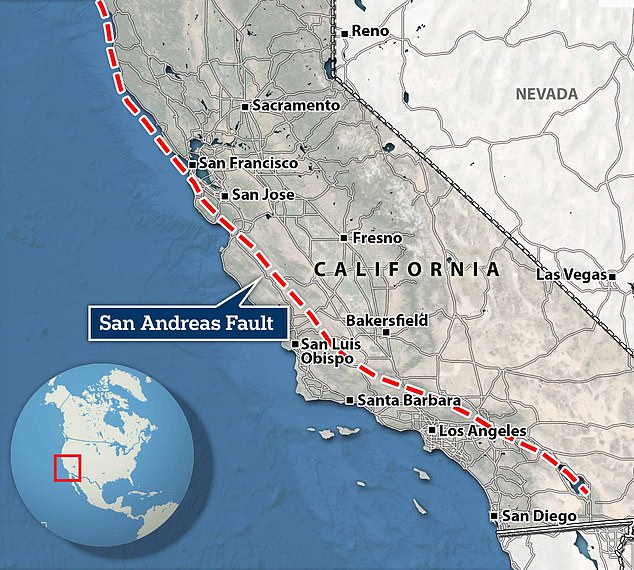California is struggling with more than 50 aftershocks after being hit by a 5.2 magnitude earthquake last night
Parts of California have been hit by more than 50 earthquakes in just 12 hours.
The United States Geological Survey (USGS) has detected at least 57 earthquakes within 20 miles (32 kilometers) of the epicenter, Kern County, which produced a magnitude 5.2 quake on Tuesday night.
The swarm had a magnitude of 2.6 to 4.5, with the largest occurring at 12:10 a.m. ET on Wednesday.
Seismologists report that the state is experiencing a “strong aftershock series, measuring 4.5 on the Richter scale, just 45 seconds after the main shock.”
The United States Geological Survey (USGS) has detected at least 57 earthquakes within 20 miles (32 kilometers) of the epicenter, Kern County, which produced a magnitude 5.2 quake Tuesday night
The first quake struck at 9:09 a.m. PST, about 14 miles (22 kilometers) southwest of Lamont.
The USGS noted, however, that aftershocks typically become less frequent as time goes on, “although they can persist for days, weeks, months, or even years with a very large main shock.”
The agency also reported that there is a 21 percent chance of another magnitude-5 earthquake in the area in the coming week. There is a 2 percent chance of a magnitude-6 earthquake.
Tuesday’s earthquake is currently the largest to hit California this year, with a magnitude 5.2 recorded on May 12, 2023 near Canyon Dam.
The Los Angeles Fire Department confirmed Tuesday night that it was in an “earthquake mode,” prompting all 106 nearby fire stations to conduct a survey of the area, on land, at sea and in the air.
“There are no initial reports of structural damage or injuries at this time. An update will be provided once LAFD Earthquake Mode is complete,” officials said in a news release.
Residents of Ventura, Simi Valley, Camarillo, Santa Clarita, Encino, Hollywood, Santa Monica, North Hollywood and Woodland Hills reported feeling the tremor.
Although the strongest quake was felt more than 100 miles (160 kilometers) from the epicenter, many aftershocks may have gone unnoticed.
A study from Michigan Tech University found that people generally do not feel earthquakes of magnitude 2.5 or less.
Damages from 2.5 to 5.4 are often felt, but cause only minor damage.
A Los Feliz resident described feeling three distinct waves—one weak, followed by a strong one, then another weak one—all within a 45-second span.

The swarm ranged in magnitude from 2.6 to 4.5, with the largest occurring at 12:10 p.m. ET on Wednesday.

Bakersfield is located near several major fault lines, including the San Andreas. Experts say this fault line will one day produce a devastating 8.3 magnitude earthquake, which is considered the “Big One.”
In South Pasadena, another person felt vibrations for 20 seconds, divided into two distinct waves.
According to the Los Angeles Times, an average of five earthquakes measuring 5.0 to 6.0 occur each year in California and Nevada.
Bakersfield is located near several major fault lines, including the San Andreas. Experts say this fault line will one day produce a devastating 8.3 magnitude earthquake, also known as the “Big One.”
According to the California Earthquake Authority, the natural disaster would cause devastation within a 100-mile radius of the fault line, which begins near Eureka and ends below Palm Springs. At least 1,800 people would die, millions of homes would collapse and more than $290 billion in damage would be caused.
According to the U.S. Geological Survey (USGS), the next major earthquake to hit Los Angeles would likely start 1,600 fires and trap 750 people in buildings, and would take two and a half weeks to search and rescue.
According to the Concrete Coalition, an estimated 16,000 to 17,000 concrete buildings in 23 of California’s most earthquake-prone zones could collapse in the next major earthquake in 2011.
The zones include San Francisco (3,200 homes), Oakland (1,300 homes) and San Jose (363 homes).
The last 7.8 magnitude earthquake in California struck San Francisco in 1906, killing 3,000 people and causing $524 million in damage. By 2024, that number will have risen to $117 billion.
In 1857, another 7.9 magnitude earthquake struck the outskirts of Los Angeles. Fortunately, only two people died, as the area was uninhabited at the time.
Known as the Great Fort Tejon Earthquake, it is the second largest earthquake ever recorded in U.S. history, destroying property as far away as Santa Cruz, over 220 miles away.
According to the Los Angeles Almanac, the Los Angeles area will have 9.7 million residents in 2022. If the same magnitude were to occur today, the damage would be billions of dollars and many lives would likely be lost.
According to the USGS, there is a 60 percent chance that the southernmost region of the San Andreas will rupture with a magnitude of more than 6.7 within the next 30 years.
